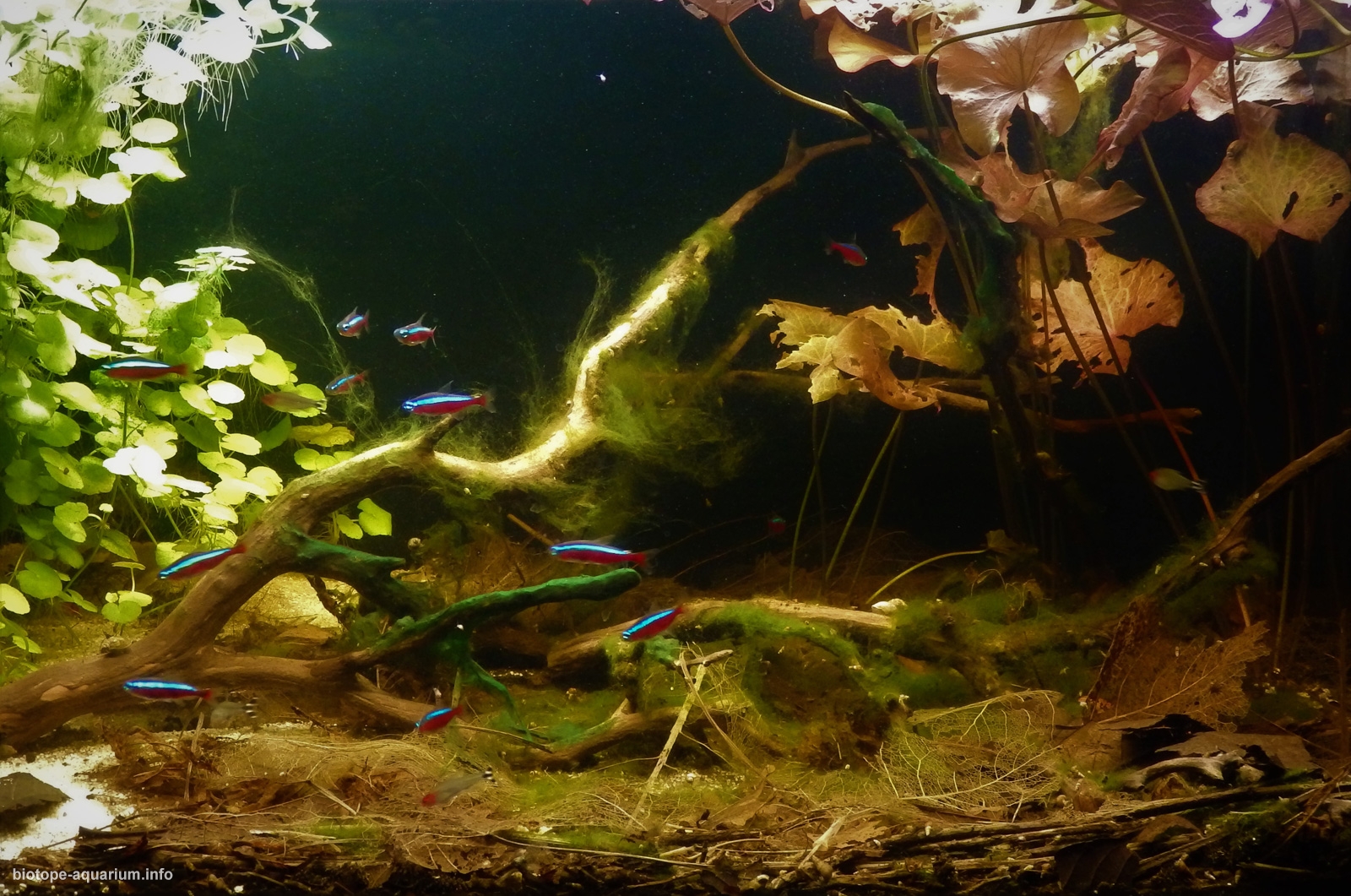Planted small affluent in the Upper Rio Araçá basin, Brazil
34th place in Biotope Aquarium Design Contest 2017
![]() Belgium. Jeroen Vanhooren
Belgium. Jeroen Vanhooren

Volume: 100 L
Dimensions: 70x33x50 cm
List of fishes: Paracheirodon axelrodi and Hemigrammus bleheri
List of plants: Not biotope correct Nymphaea sp. was used in this aquarium, given it’s red color and the unavailibility of biotope correct Nymphaea (probably rudgeana). Hydrocotyle sp. completed the scenery.
Description of decorations: Fine white sand was used, small branch, twigs, leaves at different stages of decomposition are added to give the natural feel to this biotope aquarium.
Description of equipment: Internal sump, Juwel Eccoflow 300 lph, LED lights 28W 6800 K, automatic waterchange system with dripping technology.
Water parameters: 26°C, pH 5,5, hardness not measurable (95% RO water used)
Description of the area surrounding the biotope: Rio Araçá is a right-hand affluent of Rio Demini, in turn a tributary of the Rio Negro. Rio Araçá is 390 km long blackwater river in the Amazonas state. It originates near the borders with Venezuela in Yanomami park in the Serra Tapirapeco mountains. The first 50 km it flows northwest, makes a turn and flows in southeast direction till the mouth. Soon after left the Park a huge waterfull tumbles down. After that the Araçá river has a descending course. The lower part of the river (behind confluence with Curruduri) lies in flat land and the river forms many meanders to end up in the Rio Demini. Igarapé (small affluent) and igapó (flooded forest during the rainy season) dominate the surrounding scenery. These Igarapé can only be reached by canoe during rainy season or even not reachable by boat at all, due to the dense forest. As can be expected the season has a huge influence on these surroundings and is the driver for the behaviour/reproduction of fishes and plantlife. Although nutrients in this area are poor and few light penetrates through the forest canopy, one can find special places (like Igarapé Savaudaua, explored by Heiko Bleher and his team) with abundant plant growth and even clear water occur, mainly in open spaces in the forest. This tank simulates a planted area in a small Igarapé in the upper parts of the Rio Araçá and is a tribute to the two most popular ornamental fishes: Paracheirodon axelrodi and Hemigrammus bleheri. Smaller fishes use these areas for protection against predation and to feed on Perifitum (organic matter) that was caught by theleaves.
Description of the underwater landscape of the biotope: Substrate is made of fine white sand, that covers the entire region. Tree branches, twigs and leaves. Plants inthe background that provide shade and food complete this landscape.
Description of the parameters of the habitat: pH is very low (4-6) with very low conductivity. Temperature 25-29°C. In this specific habitat the water is tea-coloured.
List of fishes: In these Igarapé numerous fish species live like Paracheirodon axelrodi, Paracheirodon simulans, Hemigrammus bleheri, Apistogramma cf. gibbiceps, Apistogramma cf. paucisquamis, Apistogramma cf. pertensis, several Nannostomus sp., Carnegiella marthae, Copella cf. nattereri, Rivulus ornatus, Pyrrhullina sp. Brittanichthys sp., Iguanodectes geisleri, Crenicichla sp., different Loricariidae…
List of plants: In this specific biotope many Nymphaea sp., mostly small under water (red coloured), Eleocharis sp., Mayaca sp. and Hydrocotyle sp. In the broader region Utricularia, Sagittaria, Cyperus, Nymphoides, Salvinia, Najas, Nitella and many, many more.
Sources of information:
- Bleher’s Biotopes (p.406-421)
- http://www.aquatic-experts.com/Cardinal_Tetras_in_Their_Natural_Habitat_ARTICLE.html
- http://cefishessentials.com/blog/the-route-of-the-cardinal-tetra-paracheirodon/
- https://es.wikipedia.org/wiki/R%C3%ADo_Ara%C3%A7%C3%A1
- https://archive.org/stream/Practical_Fishkeeping_September_2015_UK/Practical_Fishkeeping_September_2015_UK_djvu.txt
- http://www.aqua-aquapress.com/pdf/Biotope-ING.pdf
- http://www.practicalfishkeeping.co.uk/features/articles/cardinal-tetra-paracheirodon-axelrodi
- https://www.aqualog.de/blog/das-biotopaquarium-teil-2/
- http://onlinelibrary.wiley.com/doi/10.1111/j.1365-2427.2009.02172.x/full
- http://jms.org.br/PDF/v26n1a05.pdf
- Personal communication with Heiko Bleher and Janne Aho
